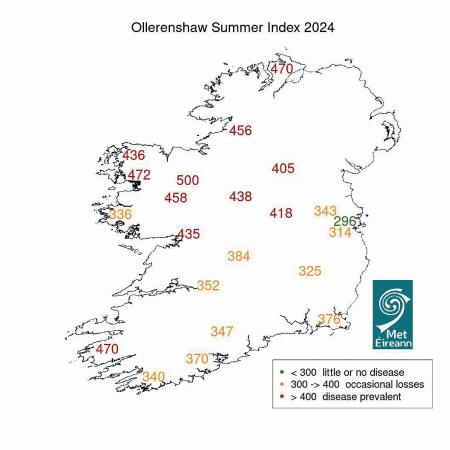-

-
Author: Francis Farragher
~ 4 minutes read
THE West, Midlands and North-West are the regions most at risk of liver fluke infection for this coming winter, according to the Ollerenshaw Summer Index 2024, published by Met Éireann.
Based on data gathered from May to October of this year, the fluke [Fasciola hepatica] advisory index is compiled by the Dept. of Agriculture, Met Éireann, UCD, Teagasc and Animal Health Ireland.
An index of over 400 indicates that liver fluke infection is prevalent and that figure is surpassed in a number of sample areas across Galway, Mayo, Roscommon, Longford Westmeath, Cavan and Donegal.
The highest reading in the country – 500 – is in the North Mayo-Sligo border area while West Conamara on 336 has one of the lowest readings in the country.
The Beef HealthCheck programme, run in partnership with Meat Industry Ireland, collects and reports liver fluke information in cattle at slaughter from participating meat factories nationwide.
While liver fluke levels have generally remained low for the last few years, this year has seen the first increase since the programme began in 2016.
To date this year, abattoir examinations showed an average of 39% of herds with at least one animal with liver fluke damage. Active infection in one or more animals was seen in 17% of herds, compared to only 13% last year.
“Counties in the northwest of Ireland were more heavily affected, with 70-80% of herds in Sligo, Leitrim, Roscommon and Donegal reported to have signs of liver fluke at slaughter.
“The prevalence within herds is typically low depending on the farm with 7% of animals presented to slaughter showing signs of liver fluke damage and 2% of animals showing live liver fluke parasites,” the fluke report states.
They also say that it is important for farmers to know whether liver fluke is present on their farm and to treat accordingly to avoid production losses.
The Beef HealthCheck data, according to the report, can be a useful tool to understand liver fluke challenge on-farm and is available to farmers on the ICBF website (beefhealthcheck.icbf.com) for those who have slaughtered animals at a participating factory since 2016.
In order to assess the risk of liver fluke disease on any particular farm, various environmental factors, particularly climate, landform and soil type (especially whether soils are heavy or free-draining) must be taken into account.
This is because the intermediate host of the parasite, which is a mud snail (Galba truncatula), occurs in soil that is slightly acidic and muddy.
Thus, areas with rushes or wet patches (e.g., around gates, troughs) are particularly important with regard to liver fluke risk as they can help to maintain a population of the infective stage of the parasite. In addition, livestock owners should factor in prior liver fluke history on the farm as this is an important indicator of future disease risks.
Liver fluke infection tends to be chronic in cattle, resulting in ill-thrift and poor performance. Though chronic disease can also occur in sheep, infections may also result in more acute clinical signs, and sudden death in cases of heavy challenge, the Summer Index report points out.
Livestock owners should be vigilant for any signs of illness or ill-thrift in their animals and consult with their private veterinary practitioner (PVP) if they are concerned.
In cases where the cause of death is not obvious, it is recommended that carcasses be referred by a PVP to the local Regional Veterinary Laboratory for post-mortem examination.
Abattoir records of livers of previously sold fattened stock is also a valuable source of information for livestock owners on the prevalence of liver fluke infection on their own farm or on the efficacy of their control programme.
■ Visit Animal Health Ireland Beef HealthCheck Map for county level maps of liver fluke infection levels and further details on the programme. Further details are available in the DAFM Liver Fluke November 2024 press release on Gov.ie
Pictured: The figures in red show problem areas across the country for liver fluke, roughly coinciding with regions of heavier rainfall: West Kerry, Connacht, parts of the Midlands and Donegal.
For more, read this week’s Connacht Tribune:
Connacht Tribune Digital Edition App
Download the Connacht Tribune Digital Edition App to access to Galway’s best-selling newspaper. Click HERE to download it for iPhone and iPad from Apple’s App Store, or HERE to get the Android Version from Google Play.
Or purchase the Digital Edition for PC, Mac or Laptop from Pagesuite HERE.
Get the Connacht Tribune Live app
The Connacht Tribune Live app is the home of everything that is happening in Galway City and county. It’s completely FREE and features all the latest news, sport and information on what’s on in your area. Click HERE to download it for iPhone and iPad from Apple’s App Store, or HERE to get the Android Version from Google Play.
More like this:

Traumatised mum wants full review of UHG maternity services
The mother of a baby who suffered head injuries while being delivered at University Hospital Galw...

Russell completes a fairytale season with Player of the Year award
JULIA-Ann Russell completed the comeback of all comebacks when she was chosen as the PFA Ireland ...

Galway IFA seek to fill vacancies across five agricultural sectors
IFA branches across the county have been invited to consider nominations for a number of commodit...

Cunningham Autopoint’s BYD delight
Motor Distributors Limited has announced the appointment of prominent motor retailers Cunningham ...

Tynagh/Abbey-Duniry men secure provincial title glory
Tynagh/Abbey-Duniry 0-19 Tooreen 1-14 By DARREN KELLY AT DR HYDE PARK TYNAGH/Abbey-Dunir...

Festive magic in Blue Teapot’s show for kids
Arts Week with Judy Murphy Five years ago, when Rod Goodall, formerly of Footsbarn and Macnas ...

Best of Black Friday beauty buys
Health, Beauty and Lifestyle with Denise McNamara If you’re in the business of buying and aski...

Best of us – Galway’s People of the Year
Ten of the city and county’s finest groups and individuals were recognised for their commitment o...

The people will have spoken but what will they have said?
World of Politics with Harry McGee It’s the little things that trip you up, as the late Albert...
Sign Up To get Weekly Sports UPDATES


